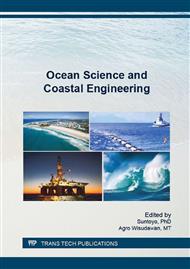[1]
C. P. Morice, J. J. Kennedy, N. A. Rayner, and P. D. Jones, Quantifying uncertainties in global and regional temperature change using an ensemble of observational estimates: The HadCRUT4 data set, J. Geophys. Res., 117 (2012).
DOI: 10.1029/2011jd017187
Google Scholar
[2]
S. Levitus. et al. World ocean heat content and thermosteric sea level change (0-2000 m), 1955-2010, Geophys. Res. Lett., 39 (2012)L10603.
DOI: 10.1029/2012gl051106
Google Scholar
[3]
W. R. Hobbs, and J. K. Willis Detection of an observed 135 year ocean temperature change from limited data, Geophys. Res. Lett., 40 (2013) 2252–2258.
DOI: 10.1002/grl.50370
Google Scholar
[4]
A. S. Gardner, G. Moholdt, J. G. Cogley, B. Wouters, A. A. Arendt, et al. A reconciled estimate of glacier contributions to sea level rise, 2003-2009, Science, 340, (2013) 852–857.
DOI: 10.1126/science.1234532
Google Scholar
[5]
P. Wadhams, N. Hughes, and J. Rodrigues, Arctic sea ice thickness characteristics in winter 2004 and 2007 from submarine sonar transects, J. Geophys. Res., 116 (2011).
DOI: 10.1029/2011jc006982
Google Scholar
[6]
Esteves LS, William JJ, Brown JM. Looking for evidence of climate change impacts in the eastern Irish Sea. Natural Hazards and Earth System Sciences, 11 (2011) 1641-1656.
DOI: 10.5194/nhess-11-1641-2011
Google Scholar
[7]
S.J. Williams,. Sea-level rise implications for coastal regions. In: Brock, J.C.; Barras, J.A., and Williams, S.J. (eds. ), Understanding and Predicting Change in the Coastal Ecosystems of the Northern Gulf of Mexico, Journal of Coastal Research, Special Issue 63 (2013).
DOI: 10.2112/si63-001.1
Google Scholar
[8]
Boon, J.D., Brubaker, J.M., and Forrest, D.M., 2010, Chesapeake Bay land subsidence and sea level change-An evaluation of past and present trends and future outlook: Virginia Institute of Marine Science Special Report 425 in Applied Marine Science and Ocean Engineering, (2010).
Google Scholar
[9]
W. SHolbrook, Marine seismic imaging: Illuminating Earth's structure, climate, oceans and hazards. Report to the National Science Foundation (2010): 1-9.
Google Scholar
[10]
T. Lay. Seismological grand challenges in understanding Earth's dynamic systems. Report to the National Science Foundation, IRIS. Consortium. (2009). 76 pp.
Google Scholar
[11]
N. Mimura. Sea-level rise caused by climate change and its implications for society. Proceeding of the Japan Academy Series B, Physical and Biological Sciences. 89 (7), (2013): 281–301.
DOI: 10.2183/pjab.89.281
Google Scholar
[12]
Roy K Dokka. The role of deep processes in late 20th century subsidence of New Orleans and coastal areas of southern Louisiana and Mississippi. Journal of Geophysical Research116 (B06403), (2011) 1-25.
DOI: 10.1029/2010jb008008
Google Scholar
[13]
M. Sneed, J. Brandt, and M. Solt. Land Subsidence alang the Delta-Mendoltakanal in the Northem Part of the San Joaquin Valley, California. USGS Scientific Investigations Report (2013) 5142.
DOI: 10.3133/sir20135142
Google Scholar
[14]
R.A. Morton, and J. C Bernier. Recent subsidence-rate reductions in the mississippi delta and their geological implications. Journal of Coastal Research, 26(3), (2010)555–561.
DOI: 10.2112/jcoastres-d-09-00014r1.1
Google Scholar
[15]
A.H. Sallenger Jr., K.S. Doran, and P.A. Howd. Hotspot of accelerated sea-level rise on the Atlantic coast of North America. Nature Climate Change 2 (2012) 884-888.
DOI: 10.1038/nclimate1597
Google Scholar
[16]
Y. Wada, L.P.H. van Beek, C.M. van Kempen, J.W.T.M. Reckman, S. Vasak, and M.F.P. Bierkens. Global depletion of groundwater resources, Geophysical Research Letters, (2010).
DOI: 10.1029/2010gl044571
Google Scholar
[17]
Kolker, A.S., Allison, M.A., Hameed, S., 2011. An evaluation of subsidence rates and sea-level variability in the Northern Gulf of Mexico. Geophysical Research Letters 38 (2011) L21404.
DOI: 10.1029/2011gl049458
Google Scholar
[18]
S. Rahmstorf, M. Perrette, and M. Vermeer, Testing the robustness of semiempirical sea level projections. Clim. Dyn., 39 (2012) 861–875.
DOI: 10.1007/s00382-011-1226-7
Google Scholar
[19]
IPCC, Climate Change 2014: Synthesis Report. Contribution of working Group I, II, II to the Fifth Assesment Report of the Intergovermental Panel on Climate Change [Core Writing Team, R.K. Pachauri and L. A Meyer (eds)]. IPCC, Geneva, Switzerland, (2014).
DOI: 10.1017/cbo9781107415416
Google Scholar
[20]
M. Hulme, Wigley, T., Barrow, E., Raper, S., Centella, A., Smith, S. and A.C. Chipanshi. Using a climatic Scenario Generator for Vulnerability and Adaptation Assessments: MAGICC and SCENGEN Version 2. 4 Workbook. Climatic Research Unit, Norwich UK, (2000).
Google Scholar
[21]
Pariwono, . Gaya Penggerak PasangSurut, PasangSurut, Ed. Ongkosongo O.S.R., andSuyarso, P3O-LIPI, Jakarta (1989) 13-23.
Google Scholar
[22]
A Susandi, Projection Of Climate Change Over Indonesia Using MAGICC/SCENGEN, poster section in of the International Conference on Mathematics and Natural Sciences (ICMNS), Bandung, Indonesia, November (2006) 29-30.
Google Scholar
[23]
B Tiwari, S. Fanaiyan, R. Hastings, and C. Olgun. 2014. Reduction In Seismic Ground Shaking With The Use Of Soil-Cement Panels. Geo-Congress Technical Papers (2014) 1186-1195.
DOI: 10.1061/9780784413272.115
Google Scholar
[24]
Morita, T., Y. Matsuoka, I. Penna, and M. Kainuma. Global Carbon Dioxide Emission Scenarios and Their Basic Assumptions: Survey, CGER-1011 -94. Center for Global Environmental Research, National Institute for Environmental Studies, Tsukuba, Japan (1994).
Google Scholar


